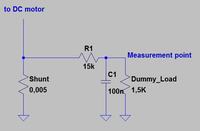gonespa
Member level 1
Hi,
I am trying to measure (precission is not a concern) the current used by a RC brushed DC motor (the kind used on RC cars). The idea is to simply identify locked rotor conditions by measuring the current via ADC port of the PIC and comparing it continuously on software to a reference value. (I know this is not the best method, but I am trying just to experiment).
To control the speed I am using a PIC microcontroller, PWM at about 20 KHz, a mosfer controller UCC37325P and a MOSFET IRF3707 protected by a fast diode DSEP 29-06A. (in a low-side drive configuration).
To measure the current, a simple piece of wire in a breadboard of about 5cm is being used as a shunt (22 AWG, 5cm length , equals about 0,005 Ohm, in fact I made a small circuit in the breadboard to check this value, obtaining a resistance of 0,00538 Ohm).
I measured the locked rotor condition current with a multimeter of about 7 Amps so, initially, I thought abaout programming to PIC to detect a condition where the motor used more than 3 Amps, just to check the concept. I decided to use low pass filter with a frequency cutt-off of about 100Hz (Resistance = 15K in series, Capacitor 100nF to ground) and feed that output to the non inverting input of an Opamp (LM358N series), obtaining a 101 Gain through a 100K resistor to the inverting input, 1K from there to ground. Opamp Output directly connects to ADC port.
With this values, at 7 amps, Voltage should be to 3.535 Volts (considering the OpAmps is not rail to rail and so will never output 5 volts, by the way the voltage fed to it). At 3 amps, 1,515 Volts.
The thing is, measuring voltage in the output of the opamp shows the RC filtering is not doing it´s work. I order to simplify all this and to ensure the ADC port or the Opamp is not influencing in this, I just eliminated the opamp completelly and simply connected the RC filter to the Shunt, and a dummy Load (resistance of 1,5K), and obtained the attached oscilloscope measurement

This is basically a reduced version (in terms of voltage) of the MOSFET switching waveforms.
The simplified part of the circuit where voltage measurement is made

Does anybody know what can be happening here?
I am trying to measure (precission is not a concern) the current used by a RC brushed DC motor (the kind used on RC cars). The idea is to simply identify locked rotor conditions by measuring the current via ADC port of the PIC and comparing it continuously on software to a reference value. (I know this is not the best method, but I am trying just to experiment).
To control the speed I am using a PIC microcontroller, PWM at about 20 KHz, a mosfer controller UCC37325P and a MOSFET IRF3707 protected by a fast diode DSEP 29-06A. (in a low-side drive configuration).
To measure the current, a simple piece of wire in a breadboard of about 5cm is being used as a shunt (22 AWG, 5cm length , equals about 0,005 Ohm, in fact I made a small circuit in the breadboard to check this value, obtaining a resistance of 0,00538 Ohm).
I measured the locked rotor condition current with a multimeter of about 7 Amps so, initially, I thought abaout programming to PIC to detect a condition where the motor used more than 3 Amps, just to check the concept. I decided to use low pass filter with a frequency cutt-off of about 100Hz (Resistance = 15K in series, Capacitor 100nF to ground) and feed that output to the non inverting input of an Opamp (LM358N series), obtaining a 101 Gain through a 100K resistor to the inverting input, 1K from there to ground. Opamp Output directly connects to ADC port.
With this values, at 7 amps, Voltage should be to 3.535 Volts (considering the OpAmps is not rail to rail and so will never output 5 volts, by the way the voltage fed to it). At 3 amps, 1,515 Volts.
The thing is, measuring voltage in the output of the opamp shows the RC filtering is not doing it´s work. I order to simplify all this and to ensure the ADC port or the Opamp is not influencing in this, I just eliminated the opamp completelly and simply connected the RC filter to the Shunt, and a dummy Load (resistance of 1,5K), and obtained the attached oscilloscope measurement

This is basically a reduced version (in terms of voltage) of the MOSFET switching waveforms.
The simplified part of the circuit where voltage measurement is made

Does anybody know what can be happening here?
Last edited:






